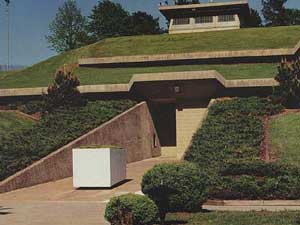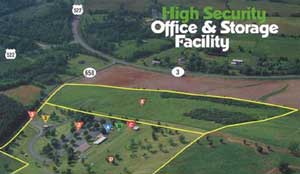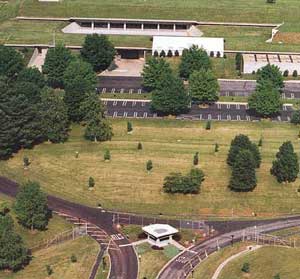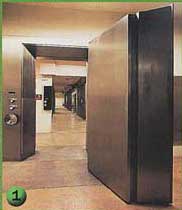|
 A Cold War emergency bunker nestled in the side of a mountain will soon house one of the largest movie and music collections in the world. A Cold War emergency bunker nestled in the side of a mountain will soon house one of the largest movie and music collections in the world.
The Federal Reserve's hidden facility in Mount Pony, near Culpeper, Virginia, was decommissioned by the government in the 1990s. But next year, it will be resurrected as the Library of Congress' new National Audiovisual Conservation Center.
The building's solid underground structure, complete with vaults, converts easily to media storage, said Gregory Lukow, chief of the motion picture, broadcasting and recorded sound division of the Library of Congress. And the facility has a unique history, to put it mildly.
"It was built into a mountainside facing away from Washington, and it was a place where approximately $3 billion in coin and currency was stored for re-priming the American economy in case of a nuclear holocaust," Lukow said. And it was "a place where members of the Federal Reserve Bank and commission could flee in case of a nuclear attack."
 The project, funded by the Packard Humanities Institute, is an effort to expand the Library of Congress' storage facilities for films, television programs, videos and recorded sound. The project, funded by the Packard Humanities Institute, is an effort to expand the Library of Congress' storage facilities for films, television programs, videos and recorded sound.
The National Audiovisual Conservation Center will open in two phases. The library will begin moving its collections into the existing retrofitted Federal Reserve building in June 2005. In the second phase, opening in April 2006, new construction alongside the mountain will house collection-processing areas, preservation laboratories and staff. The NAVCC will also include 122 vaults designed to store nitrate motion picture films -- movies created in the early days from the 1890s to 1951 -- which are highly flammable and must be stored separately from other media.
The center will have four temperature zones for storing master copies of films, non-master copies, magnetic media like audio and videotapes, and the nitrate motion pictures.
 "It's not something you just do in an office building, no matter how large," Lukow said, adding that the collections building alone is 140,000 square feet. "The new spaces are being designed specifically for increased capability and capacity for our preservation work. It will enable us to significantly increase our preservation output for all audiovisual formats." "It's not something you just do in an office building, no matter how large," Lukow said, adding that the collections building alone is 140,000 square feet. "The new spaces are being designed specifically for increased capability and capacity for our preservation work. It will enable us to significantly increase our preservation output for all audiovisual formats."
Rick Prelinger, who donated the bulk of his 48,000 educational, industrial, advertising and documentary films to the Library of Congress, has toured the facility as a member of the National Film Preservation Board.
"You always hear about these Cold War secret underground sites, but I'd never been in one," Prelinger said.
Old guard towers, 50-ton doors, dormitories and gyms are just a few of the features he observed when visiting the facility. He said there are doors in the walls that look like cupboards, but when opened lead into a cave "like Lord of the Rings."
As an individual collector, he worried about ensuring the safety of his films over time on his own. Risks included fire, water and vandalism. He's thrilled that the Library of Congress has a new secure building to store his former collection.
 "The library is going to take the physical protection of materials very seriously," Prelinger said. "They have a very good track record at preserving delicate historical documents." "The library is going to take the physical protection of materials very seriously," Prelinger said. "They have a very good track record at preserving delicate historical documents."
Even in the digital age, it's crucial to preserve the original analog material, said Paul Conway, director for information technology services at Duke University Libraries.
"I'm a big fan of these preservation facilities for the raw material, simply because it gives us more choice and more time," he said. "It's a really worthwhile investment. The originals have to be maintained as the ultimate backup.
"The more care we extend to these artifacts, the more time we have to make them digital," Conway said. In digital form, the materials are also more accessible to regular people.
The NAVCC will be open to the public, but primary access to the library's collection will remain in the reading room in the James Madison building at the Library of Congress on Capitol Hill, Lukow said.
This isn't the only film preservation archive funded by the Packard Humanities Institute. PHI has also purchased land in the Santa Clarita Valley to build a film storage and conservation facility on the West Coast. It will be owned and operated by UCLA.
"This is the memory of America," Lukow said. "Our social, cultural, aesthetic lives cannot be understood without benefit of moving images and recorded sounds that document who we are, what we did, what we imagined or believed or aspired to."
|